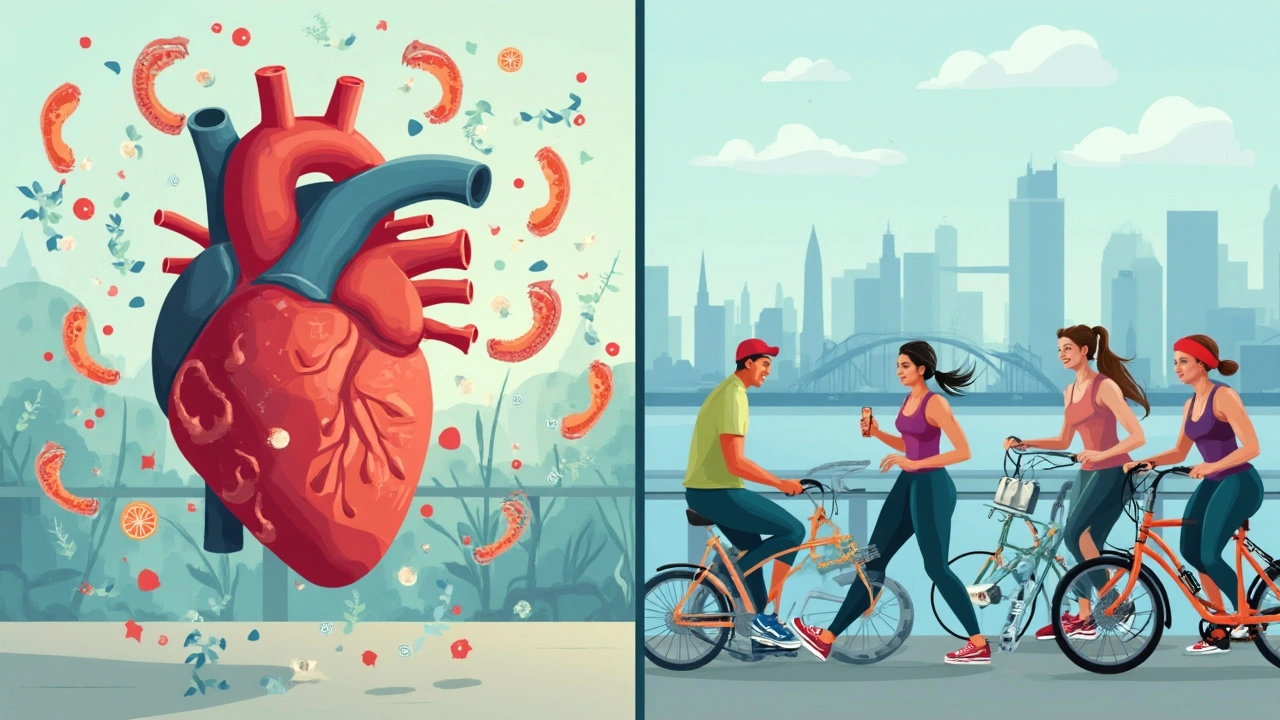Your body doesn’t lie. If the scale hasn’t budged, it’s not your imagination or metabolism playing tricks on you. That nagging thought—"Is 30 minutes of cardio a day enough to lose weight?"—is more common than you’d think. All those gym selfies, sweaty treadmills, and heart-pumping spin classes come down to one simple question: is this really helping? Nobody wants to waste their time on something that won’t work. Let’s cut through the noise, bust some myths, and get real about what it actually takes to drop those extra pounds with cardio.
The Science Behind Cardio and Weight Loss
Cardio is everywhere these days, from HIIT bootcamps blasting through your Instagram feed to those long runs your friend brags about every weekend. At its simplest, cardio—or aerobic exercise—is anything that gets your heart rate up and keeps it there for a while: running, brisk walking, cycling, jumping rope, you name it. You probably already know cardio burns calories. But here’s the clincher: to lose weight, you’ve got to burn more calories than you take in. There’s no way around that eternal rule, not even with the snazziest smartwatch or cleverest diet app.
Here’s something you might not expect. A thirty-minute elliptical session for someone weighing 155 pounds burns roughly 270 calories, according to Harvard Health. A brisk 30-minute walk chews up about 150 calories. Compare that to a cheeseburger, and suddenly the math feels less generous. Cardio does torch calories, but it isn’t magic. Yes, every calorie counts, but your body is stubbornly efficient—it adapts to your routine, sometimes burning fewer calories for the same workout if you do it all the time.
This doesn’t mean thirty minutes is pointless. A huge review published in the journal Obesity in 2022 looked at people who stuck to 30-minute daily bouts of moderate-intensity cardio (the kind where you can speak in short sentences, but singing’s off the table). Over twelve weeks, most lost between five to twelve pounds, depending on diet and starting weight. So, there are real results. But here’s a twist—many didn’t lose as much as they hoped, mostly because they ate more or moved less when not exercising. Why does this happen? Well, people often overestimate calories burned or get hungrier and “reward” themselves after cardio.
There’s another angle, too. Doing thirty minutes a day boosts your cardiovascular health—a big deal for your heart, lungs, and mood. But in terms of fat loss, the number on the scale will move more dramatically if you mix up the intensity. HIIT (high-intensity interval training), for example, can burn just as many calories as steady-state cardio, sometimes even in less time. But it comes with a caveat: not everyone likes (or sticks with) HIIT, and it’s not always suitable for beginners or those with injuries.
Muscle also plays a sneaky role here. Strictly doing cardio can burn fat (and sometimes muscle, especially if you’re eating too few calories). Less muscle means a slower metabolism, making weight loss harder in the long run. So, the science says thirty minutes of cardio does help lose weight—if you’re paying attention to what and how much you eat and mixing it up with other forms of activity.

Tweaking Your 30-Minute Cardio for Better Results
Just showing up isn’t quite enough. Here’s the real kicker: it’s not only the length of your cardio sessions, but how you do them that matters. You can’t out-exercise a diet that’s out of control, but you can fine-tune your 30 minutes to work smarter, not harder.
Intensity is hugely underrated. Ever notice how huffing through interval sprints or jumping jacks feels more taxing than trudging along on a treadmill? That’s not accidental. Higher-intensity bursts spike your heart rate, making your body torch fat both during and after your workout. Researchers at the University of New South Wales spotted that even just a few high-intensity intervals inside a 30-minute workout causes your body to burn extra calories hours later (it’s called EPOC, or the "afterburn effect").
But you don’t need to go all-out every day. A smart approach blends in variety: some days, you walk or cycle briskly; other days, you push the pace, adding sprints or challenging hills. This variation keeps things fresh, minimizes boredom, and forces your body to adapt, avoiding weight loss plateaus.
Now, let’s talk about timing. Does morning cardio torch more fat? Studies are mixed. Some say fasted cardio (working out before breakfast) can bump up fat burning slightly, but the difference is smaller than Instagram fitness ‘gurus’ claim. What really matters is consistency. The “best” time for your body is the time you’ll actually do it, whether that’s before sunrise or after work.
Don’t forget to upgrade your 30 minutes with little adjustments that make a big difference:
- Switch up your playlist to boost motivation—music with 120-140 bpm can help push your speed and endurance.
- Grab a workout buddy for accountability. People tend to push themselves harder and show up more consistently if someone’s counting on them.
- Add quick bodyweight moves every five minutes—think 10 burpees or 20 squats—to your run, walk, or bike routine if you’re up for it.
- Include hills or incline intervals if you’re on a treadmill or stationary bike for a quick intensity upgrade.
- Track your progress, but not just with the scale. Take waist measurements or note how you feel walking up stairs—these real-life cues beat the number obsession.
Now, if you’re short on time, split your workout—two 15-minute bursts can be just as effective as one 30-minute session, according to the American College of Sports Medicine. That way, squeezing in exercise feels less like a chore and more like a normal part of life.

Eating and Lifestyle Factors That Make Cardio Count
Here’s where most people trip up—assuming cardio alone is their golden ticket to weight loss. Everyone’s heard, “Abs are made in the kitchen.” It’s annoyingly true. If you’re eating more calories than you burn — even with daily 30-minute cardio — that stubborn belly isn’t going anywhere.
So, what actually helps? The magic word: deficit. Creating a calorie deficit (burning more calories than you take in) makes your body turn to stored fat for energy. Simple, but not always easy. On average, a deficit of 500 calories per day leads to about a pound of fat loss per week. You could burn 250 calories with cardio and trim another 250 from your meals, for example. Tracking what you eat—even for just a week—opens most eyes. People are notoriously bad at estimating their real calorie intake. Ever measured peanut butter or salad dressing? Those little extras sneak up fast.
Protein helps more than most folks realize. Getting enough protein keeps you full and protects your muscles while you lose fat. That means you’re less likely to lose muscle (which you worked so hard for with your cardio for weight loss), and your metabolism stays higher. Aim for protein at every meal: eggs, lean meat, tofu, yogurt, lentils—boredom is harder when you mix it up.
Sleep is the hidden hero. Skimping on sleep messes with your hunger hormones, ramps up cravings, and makes willpower dip. Harvard scientists found people who sleep at least seven hours lose more fat than those who don’t, even when doing the same workouts.
Stress matters, too. High stress cranks up cortisol, a hormone that can make your body hold onto fat (especially around your belly). Even with steady workouts, being wound up can blunt your progress. Tactics like deep breathing, yoga, or even a walk in the fresh air can help dial down stress.
But here’s something less talked about—how you see yourself affects how consistently you train. According to the Journal of Health Psychology, individuals with better body image are significantly more likely to stick with workout plans long-term, regardless of their weight loss speed. That matters, because consistency, not perfection, is what drives results.
It’s also why expanding your idea of what “fit” or “beautiful” looks like can be a game-changer. If you’ve ever struggled with feeling not “good enough” during your fitness journey, this guide explores how fuller-figured women are redefining confidence and attractiveness—especially in spaces where realness matters more than perfection. Sometimes, the best way to stay motivated isn’t to chase someone else’s ideal, but to see how real beauty is already being embraced, celebrated, and desired.
Finally, don’t ignore strength training. Adding even two brief sessions a week helps maintain lean muscle, makes your body burn more calories at rest, and improves your shape. Cardio is powerful, but pairing it with weights or resistance bands? That’s when you start seeing serious changes, inside and out.
To sum up, 30 minutes of cardio a day really can chip away at unwanted fat—but only if it goes hand-in-hand with smart eating, varied intensity, and some muscle work. Real-world results don’t happen overnight, but with consistency, plenty of water, and a dash of patience, you’ll start to see—and feel—the payoff.
